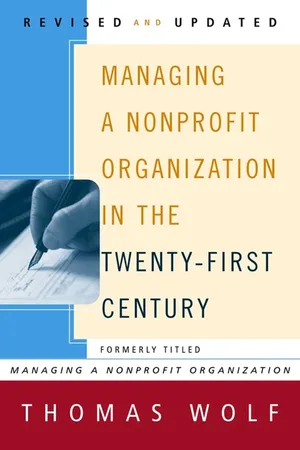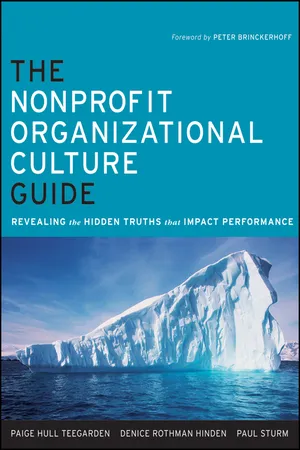Business
Non-Profit
A non-profit organization is a type of business that operates for the benefit of the public or a specific cause, rather than to generate profit for owners or shareholders. Non-profits often rely on donations, grants, and fundraising to support their activities and typically have a mission focused on social, environmental, or charitable goals.
Written by Perlego with AI-assistance
Related key terms
7 Key excerpts on "Non-Profit"
- eBook - ePub
Financial Management for Nonprofit Organizations
Policies and Practices
- Jo Ann Hankin, Alan Seidner, John Zietlow(Authors)
- 2011(Publication Date)
- Wiley(Publisher)
The trustees are legally responsible for periodically reviewing the nonprofit organization’s bylaws and articles of incorporation to ensure that they accurately reflect what is happening in the organization. It is also the trustees’ responsibility to ensure that those provisions of the governing documents are followed.Once these two documents are in place, the trustees should develop policy manuals covering their own service, personnel, finances, equipment, and other areas. These policies should address issues related to the operational and financial means of implementing the organizational mission, such as conflict of interest, human resource management, cash controls, cash management, investment guidelines, debt and liability guidelines, risk management, property, and facility use.1.2 CHARACTERISTICS OF NONPROFIT ORGANIZATIONS
A nonprofit organization has most or all of these characteristics:- Public service mission
- Organizational structure of a not-for-profit or charitable corporation
- Governance structures that preclude self-interest and personal financial gain
- Exemption from paying federal taxes
- Special legal status stipulating that gifts made to the organization are tax-deductible
(a) ORGANIZATIONAL MISSION.
One essential difference between a nonprofit and for-profit corporation centers on its mission. The ultimate mission of for-profit organizations is to make money for the owners/shareholders, ranging from an individual, as sole proprietor, to corporate ownership through the purchase of shares.A nonprofit organization does not include the concept of ownership and, therefore, has a completely different thrust. Its mission is to serve a broad public purpose, which is clearly incompatible with ownership and personal gain. This prohibition of “private inurement” does not prevent nonprofit organizations from paying salaries to their employees, including the chief executive officer or chief financial officer. The board members typically donate their time as a public service and receive no compensation. - eBook - ePub
- Bruce R. Hopkins(Author)
- 2015(Publication Date)
- Wiley(Publisher)
profit (that is, an excess of revenue over expenses). In fact, is it quite common for nonprofit organizations to generate profits. Rather, the definition of nonprofit organization essentially relates to requirements as to what must be done with the profits earned.A nonprofit organization may be contrasted with a for-profit organization. The for-profit organization has owners that hold equity in the enterprise, such as stockholders of a corporation. For-profit entities are operated for the benefit of their owners: the profits of the business undertaking are passed through to them, such as by the payment of dividends on shares of stock. That is what is meant by the term for-profit organization: It is one designed and operated to generate a profit for its owners. The transfer of profits through the organization to its owners is known as private inurement.By contrast, nonprofit organizations are not supposed to engage in private inurement. They are expected to devote their profits to their nonprofit purposes and activities. Consequently, the doctrine of private inurement is the substantive defining characteristic that distinguishes nonprofit organizations from for-profit entities.Another source of confusion is use of the term tax-exempt organization. The two terms do not mean the same, although there is considerable overlap. An organization can be a nonprofit one without being tax-exempt. Nearly all tax-exempt organizations, however, are nonprofit entities. State law usually determines whether an organization is a nonprofit entity. The federal tax law generally is the basis for an organization’s tax-exempt status (if any).A third source of confusion is the term charitable organization. Just as all nonprofit organizations are not tax-exempt, not all tax-exempt organizations are charitable in nature. The term charitable, while it certainly has its technical elements, generally embraces organizations that are educational, scientific, religious, and the like. The Supreme Court held that all of these organizations must meet “certain common law standards of charity—namely, that an institution seeking tax-exempt status [as a charitable entity] must serve a public purpose and not be contrary to established public policy.” Further, contributions to these entities are generally eligible for the charitable contribution deduction - Thomas Wolf(Author)
- 2009(Publication Date)
- Free Press(Publisher)
Suppose you asked someone, “What is an elephant?” and the person answered, “An elephant is a nonhorse.” You would probably find the answer unsatisfactory. Yet, the term nonprofit organization describes something that is not something else—it suggests a business enterprise not organized to make a profit. But it tells us very little about the essential characteristics of this type of entity.It is not easy to describe nonprofit organizations and this is partly what makes managing them such a difficult task fraught with challenges and problems. Unlike management issues in the profit sector, which tend to be clear and related to specific economic measures, issues in the nonprofit environment are more nebulous because they relate to the somewhat abstract concept of public service. In a profit-making company, a manager generally knows whether he or she is doing a good job, but it is often less clear in a nonprofit organization in which the primary purpose is not to make money but to serve the public.Some say that the essential defining characteristic of nonprofit organizations is the fact that they are established to provide a service to the public, and to some extent this is true. But this idea of a public service mission can be misleading. For one thing, there are a number of nonprofit organizations that are not organized to serve the public (for example, country clubs and labor unions). For another, the idea that nonprofit organizations are simply organized to solve some societal problem or deliver some much-needed public service flies in the face of the exclusivity often associated with their respective constituencies. This is perhaps most clear when nonprofit organizations are compared to public (or government) organizations and agencies working in the same field. Although the nonprofit organizations often have a stated public service mission, they do not necessarily have a requirement of equity (that is, a mandate to serve everyone) the way public agencies usually do. As a result, the nonprofit organization’s actual constituency may be far more limited than that of a public agency working in the same field.- eBook - ePub
The Nonprofit Organizational Culture Guide
Revealing the Hidden Truths That Impact Performance
- Paige Hull Teegarden, Denice Rothman Hinden, Paul Sturm(Authors)
- 2010(Publication Date)
- Jossey-Bass(Publisher)
nondistribution constraint: nonprofit organizations can only retain and distribute revenue and assets for specified organizational purposes. Nonprofit organizations (like all corporations) must be governed by boards of directors; the directors’ legal duties vary by state, but usually include a duty of obedience to the organization’s mission. The duty of obedience to mission is somewhat different from the duties of directors of for-profit businesses. An additional difference is that traditionally board members of nonprofits are volunteers. There are many IRS categories for nonprofit organizations. For 501 (c)(3) organizations, their purpose must be charitable. In some ways, legal and procedural requirements are expressions of the political and economic theories about why nonprofits exist, and further distinguish nonprofits from business and government (Oleck, 1988).The echoes of economic theories about the existence of nonprofits are seen in the nondistribution constraint. A nonprofit organization’s net proceeds cannot be distributed among members or owners. An underlying idea here is that a nonprofit organization is not driven by the goal of maximizing the financial bottom line and, instead, focuses on quality or on serving more people. (A similar concept was expressed in the contract failure theory; nonprofits are trustworthy because they are not profit driven.) In many organizations, this emphasis on quality and quantity has led to the placing of heightened value on the professional opinion of the staff providing services or running programs. In such nonprofits, conversations and behavior focus on how to improve the quality or quantity of services. On the level of organizational culture, this means many nonprofits will have chosen early in their lives to focus on quality and quantity, and the behaviors based on this decision are likely to be deeply ingrained. A corollary is that such organizations will focus energy on the mission or cause rather than on profit (or surplus revenue). Therefore, successes for the organization are likely to be related to its causes, and the beliefs and behaviors that led to these successes are likely to be deeply embedded in the organization. - eBook - ePub
Writing Off Ideas
Taxation, Philanthropy and America's Non-profit Foundations
- Randall G. Holcombe(Author)
- 2018(Publication Date)
- Routledge(Publisher)
9The Role of Nonprofit Foundations in the EconomyEconomists commonly divide the economy into two sectors: public and private. The public sector is the government, which raises its revenues through taxation and undertakes expenditures, presumably, in the public interest. The private sector consists of households and businesses, exchanging goods and services for money, and acting in their own self-interests. Nonprofit organizations do not fit neatly into either one of these categories, and have sometimes been referred to as the third sector of the economy. Some nonprofit firms, such as hospitals, do exchange fees for services, and so bear closer resemblance to private sector firms, even though they may serve some charitable or public service functions. But many third sector organizations receive their revenues from voluntary contributions, rather than as coerced tax payments, or payments in exchange for goods and services, and undertake expenditures to further public interest goals, as envisioned by the donors, rather than providing essential public goods and services, or goods and services in exchange for payment. This third sector is not like the private sector, where parties to private exchanges expect to receive at least as much value as they give up in exchange, and it is not like the public sector, which forces everyone to contribute and so invites everyone’s scrutiny as they evaluate what they get relative to what they give up. Those who finance the third sector do not expect to receive benefits equal to what they pay, reducing both the ability to evaluate an organization’s effectiveness and the incentive to do so. Once donors are deceased, as is the case with most of the foundations discussed here, donor oversight is impossible. Without donor oversight, and without accountability to voters or customers, the institutional setting of the third sector leaves it with relatively little accountability.John D. Rockefeller III referred to this third sector of the economy as “the invisible sector.”1 - eBook - ePub
Building Strong Nonprofits
New Strategies for Growth and Sustainability
- John Olberding, Lisa Barnwell Williams(Authors)
- 2010(Publication Date)
- Wiley(Publisher)
Lastly, it is still the case that some organizations never seem to change and still do well. Those organizations may appear antiquated, but they survive over time because they successfully establish and keep revitalizing a following of supporters who remain loyal and pass that same commitment on to other family members and friends. The organization’s brand usually has evolved to be synonymous with qualities like trust, steadfastness, and the fulfillment of mission. There are not many such groups.What Is Changing?
To begin, the age of doing good at any cost is coming to a close. Donors are no longer willing or able year after year to support the number of organizations that are appealing for funds at the levels required to provide the services needed to address community issues at the scale at which they now exist. Appeals for support to keep the organizations themselves from collapsing in times of trouble are increasingly less effective. Nonprofit organizations are the means, not the mission.If you think change is difficult you’re going to like irrelevance even less.—General Eric Shinseki, U.S. Army Chief of StaffNonprofits are expected to think more like businesses.
For many, that concept is and will be hard to understand, accept, and implement. But of all the changes taking place, this is the most universal and influential. In his monograph, Good to Great in the Social Sectors, Jim Collins points out that differences do, in fact, exist between the sectors, and these differences must be accounted for in management and planning. However, there is little dispute that the increased use of business skills, information, and methods is now important for the success of most nonprofit organizations. Ethics and the problems that arise in their absence are common to every sector.Nonprofits are beginning to use for-profit business methods.
As a result, more nonprofit board members and executives are working on effectively applying business models to improve the performance of nonprofit organizations. Among the results they are producing are an increase in the social benefits they are creating for each donated dollar and the more effective use of resources, including staff and volunteer time. Tom Ralser effectively covers this concept in his book, ROI for Non-Profits - eBook - ePub
Leadership in Nonprofit Organizations
A Reference Handbook
- Kathryn A. Agard(Author)
- 2010(Publication Date)
- SAGE Publications, Inc(Publisher)
Giving USA, 2009). The task for leaders is to make the case for these services so as to secure the resources that enable nonprofits to provide critical and essential services.The Value of Nonprofit OrganizationsThe nonprofit, charitable, and voluntary sector is important to our society. The labels used to distinguish these organizations from government and private-sector corporations reveal their merits: nonprofit, accenting altruism and disregard of self-interest; charitable, referring to reliance on donations and generosity; and voluntary, indicating the significance of volunteers as a primary resource (Salamon, 2002c).Their importance is more than ethereal. They are powerful generators of social value for certain, but they also create economic value. In the United States, these organizations are exempt from paying taxes because of their contribution to our economic, social, and political well-being. They extend the capacity of government and the private sector to be more effective. They are significant employers. They intercede when the private and public sectors fail. And yet, like all organizations, nonprofits shape and are shaped by the environment.The Compromised NonprofitIt is not surprising that nonprofit staff capacity, program quality, and operations are severely affected by the recalcitrant funding environment. The most vital resource that a nonprofit has is its people. When the organization lacks financial support, it cannot pay prevailing, living wages nor provide any guarantee of employment. Limited compensation and reduced job security breed low morale and high staff turnover, which limit organizational capacity. Time spent with clients is reduced to comply with available resources. In the human services, where the linchpin of service provision is consistency, clients may relapse because they are getting less care than workers know they need. Programs suffer as the inclination of staff to serve more and reach wider is squelched because staff is overextended.
Learn about this page
Index pages curate the most relevant extracts from our library of academic textbooks. They’ve been created using an in-house natural language model (NLM), each adding context and meaning to key research topics.






